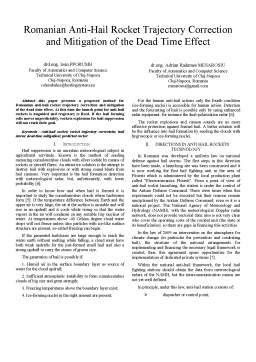Extras din referat
Abstract—this paper presents a proposed method for Romanian anti-hail rocket trajectory correction and mitigation of the dead time effect. At this time the launch point for anti-hail rockets is unguided and trajectory is fixed. If the hail forming cells moves unpredictably, rockets explosions for hail suppression will not reach their goal.
Keywords—Anti-hail rocket; rocket trajectory correctoin; hail storm; dead time mitigation; predicted rocket
I. INTRODUCTION
Hail suppression is an uncertain meteorological subject in agricultural servitude. Known is the method of seeding menacing cumulonimbus clouds with silver iodide by means of rockets or aircraft flares. An attractive solution is the attempt to destroy hail with explosives or with strong sound blasts from hail cannons. Very important is the hail formation detection with meteorological radar, but, unfortunately, with lower probability [6].
In order to know how and when hail is formed it is important to study the cumulonimbus clouds where hailstorms form [5]. If the temperature difference between Earth and the upper air is very large, the air at the surface is unstable and will rise in an updraft and it cools while rising so that the water vapors in the air will condense on any suitable tiny nucleus of water. At temperatures above -40 Celsius degree cloud water drops will not freeze unless also particles with ice-like surface structure are present, so-called freezing can begin.
If the generated hailstones are large enough to reach the warm earth without melting while falling, a cloud must have both weak updrafts for the just-formed small hail and also a strong updraft to carry the stones of grown size.
The generation of hail is possible if:
1. Humid air in the surface boundary layer as source of water for the cloud updraft;
2. Sufficient atmospheric instability to form cumulonimbus clouds of big size and great strength;
3. Freezing temperatures above the boundary layer exist;
4. Ice-forming nuclei in the right amount are present;
For the human anti-hail actions only the fourth condition (ice-forming nuclei) is accessible for human action. Detection and the forecasting of hail is possible only by using enhanced radar equipment, for instance the dual-polarization radar [6].
The rocket explosions and cannon sounds are no more effective protection against formed hail. A better solution will be the influence into hail formation by seeding the clouds with hygroscopic or ice-forming nuclei.
II. DIRECTIONS IN ANTI HAIL ROCKETS TECHNOLOGY
In Romania was developed a uniform law on national defense against hail storms. The first steps in this direction have been made, a launching site was been constructed and it is now working the first hail fighting unit in the area of Ploiesti which is administered by the local production plant called "Electromecanica Ploiesti". From a point of view of anti-hail rocket launching, the station is under the control of the Antiair Defense Command. There were times when this experiments could not be executed but their reasons remain unexplained by the Antiair Defense Command; even so it is a national project. The National Agency of Meteorology and Hydrology (NAMH), with the meteorological Doppler radar network, does not provide vectorial data; also is not very clear who cover the operating costs of the combat unit (the state or its beneficiaries); so there are gaps in financing this activities.
In the law of 2009 on intervention on the atmosphere for climate change (in particular the prevention and combating hail), the structure of the national arrangements for implementing and financing the necessary legal framework is created, thus, this agreement opens opportunities for the implementation of dedicated private systems [7].
Within the national anti-hail framework, the local hail fighting stations should obtain the data from meteorological radars of the NAMH, but the intercommunication means are not yet well defined.
In principle, under this law, anti-hail station consists of:
- dispatcher or control point;
- two or more anti-hail rockets launching
points (up to 10 stationary launching points and up to 5 aero
mobile launch platform);
- own weather station;
- communication system;
- supply and transport system;
- service personnel;
From our point of view this centralized system has the
following shortcomings:
- Its financing is not clear with the possibility that due to
subjective factors, rocket launching may not be executed when
the beneficiary wishes so (the farmer pays and the system is
not under his direct command);
- Is based on local anti-hail rockets because it is
administered by the missile manufacturer, Electromecanica
Ploiesti, there are premises for creating a monopoly on it and
could be a pressure factor in certain socio-political conditions;
- There are failures in terms of communications
redundancy, which drastically lowers the reliability;
- Responsibilities are not created if the system becomes
inefficient because of subjective reasons;
Bibliografie
[1] Prof. Dr. Ing. Clement Festila, “Optimum Speed and Acceleration Feedback for Simple Manipulators: Analisys by Simulation”, unpublished
[2] S. Bal and R. Tagawa, “Load insensitive electrical position servo: A new design method and its experimental evaluation”, unpublished
[3] Collins Radio Company, “Fundamentals of Single Side Band”, 2nd Edition, 1 September 1959, Chapter 6
[4] M.T. Abshaev, "Automated rocket technology of hail suppresion", English WMO Scientific Conference on Weater Modification, 2003
[5] Z.M. Babic, A.T. Kostic, "Automation of clouds seeding process by rocket method", English WMO Scientific Conference on Weater Modification, 2003
[6] J.Wieringa, I.Holleman, "If cannons cannot fight hail, what else ?", Meteorologische Zeitschrift, 15, issue 3, June 2006
[7] Romanian Law no. 173/2008, Decision no. 604 of 28 July 1999.
Preview document
Conținut arhivă zip
- Romanian anti-hail rocket trajectory correction and mitigation of the dead time effect.pdf







